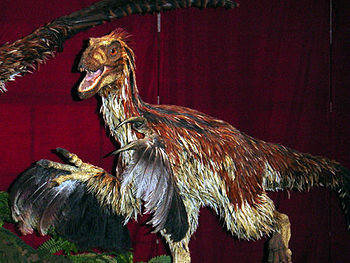| This page contains material that is kept because it is considered humorous. Such material is not meant to be taken seriously. |
| Crimsonraptor Temporal range: Late Cretaceous-Recent,
| |
|---|---|

| |
| A Crimsonraptor sighted in an park in Newark. Habitat destruction has driven many of these creatures into the cities, where some have adapted surprisingly well. | |
| Scientific classification | |
| Kingdom: | |
| Phylum: | |
| Class: | |
| Superorder: | |
| Order: | |
| Suborder: | |
| (unranked): | |
| Superfamily: | |
| Family: | |
| Subfamily: | |
| Genus: | Crimsonraptor Crimsonraptor (Wikipedia terminology), 2010
|
| Species | |
| |
| Synonyms | |
Crimsonraptor is a genus of dromaeosaurid theropod dinosaur that has existed for 75 million years (surviving through to the present via a time crack), originating in the Late Cretaceous. There is one species currently recognized, although there is a possible second species, Crimsonraptor rex, listed as a nomen dubium. The species is found throughout eastern North America, spreading from rural New Jersey. Only a few fossils have been found from this genus, but due to its existence in the present, we know a great deal about its appearance, diet, and even behavior.
Description edit
Crimsonraptor can reach a length of about 4 metres (13 ft), a hip height of about 0.91 metres (3.0 ft), and a weight of around 98 kilograms (216 lb). The skull, which contains about 60-64 serrated teeth, reaches a length of around 36 centimeters (14 inches). Fossil skull material has shown that it has binocular vision.
Crimsonraptor had large hands (manus) with three curved claws on each arm. These claws are slightly larger than in other species of raptor, which suggests an additional role in hunting. However, this has never been observed. The hands could not be pronated due to the design of the carpal bones. Each foot had a large sickle claw on the second digit, as is characteristic of all dromaeosaurids.
This dinosaur is also unique in the sense that it is the only non-avian dinosaur alive today. Therefore we can observe much more about it than a normal fossil. One discovery is the exact pattern of feathers on its body, a highlighted scarlet head crest with black flight feathers (although not actually used for flight) on the forearms. Crimsonraptor is only the third dinosaur for which we have determined color.
As of yet no person has been able to get close to a specimen, or found a dead one, so no other details are yet known.
History edit
Possible Crimsonraptor fossils have been found as far back as 1865, with reported sightings of the actual species extending as far back as before the American Revolution, possibly inspiring the myths of the Jersey Devil. However, major observations and descriptions have only occured since 2010.
A person who wishes to remain anonymous (using the actual term Crimsonraptor on Wikipedia, in reference to the species) first noticed these creatures in early April of 2010, which, after numerous views, were confirmed to be living dromaeosaurids. Our anonymous person recognized these as a new type, and named them Crimsonraptor levinus ("Levine's crimson thief", after its startling color and a character from Michael Crichton's novel The Lost World, but with indirect reference to Tony Levin of the band King Crimson). As Crimsonraptor has only been identified by one individual with no published paper and the unlikely existence of "time cracks," the dinosaur has not yet been accepted by the scientific community. However, there is a model of Crimsonraptor at the Natural History Museum of Vienna. Where this model came from is unknown.
There is a possible Crimsonraptor fossil that dates to 1865. Joseph Leidy described a single fossil tooth in Gloucester County, New Jersey and named it Tomodon horrificus. The name turned out to already be in use for a snake, so was changed three years later to Diplotomodon. This tooth has since been lost, and it is widely speculated that the genus is synonomous with Dryptosaurus. However, a recent hypothesis suggests that in fact it was from a gigantic species of Crimsonraptor, explaining sightings of unidentified but rather large reptilelike animals, which has been informally called Crimsonraptor rex. This has not been confirmed.
Classification edit
Crimsonraptor is best located in the clade Velociraptorinae, with close relatives Deinonychus, Velociraptor, and Balaur. Specifically, it is most closely related to Deinonychus, but skeleton features are characteristic of both Velociraptorinae and Dromaeosaurinae, suggesting Crimsonraptor is a link between the two clades. Below is a cladogram of Dromaeosauridae illustrating possible positions of Crimsonraptor in the family.
| Dromaeosauridae |
| ||||||||||||||||||||||||||||||||||||||||||||||||||||||||||||||||||||||||
Please note that this page is entirely fictional. It is merely a bit of fun on the user's part.
